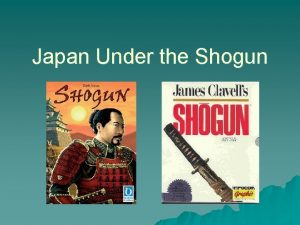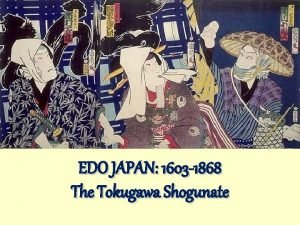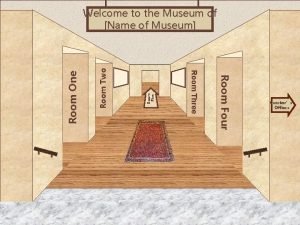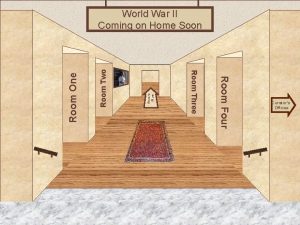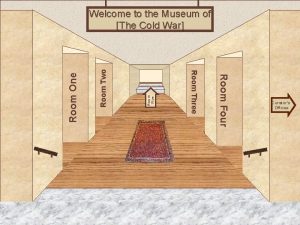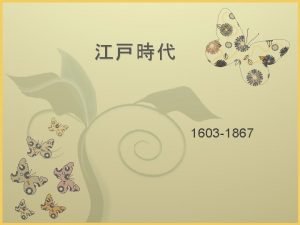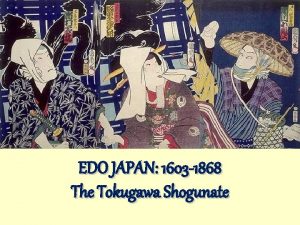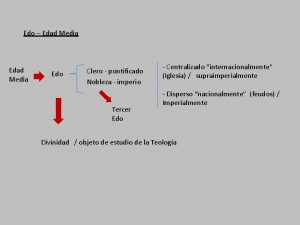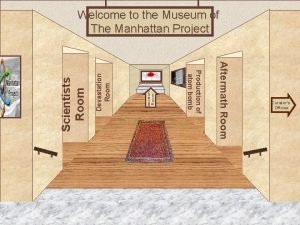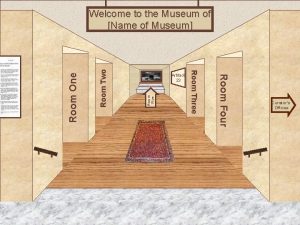Edo Period Room Scene Research 1603 1869 Edo
















- Slides: 16

Edo Period Room Scene Research 1603 -1869

Edo Period The Edo period in japan lasted from 1603 to 1869 and I sought japan develop both economically and culturally. During this time they went through a lot of changes and tweaks to their legal and social systems as well as manufacture.

Room Designs

Room Designs

Room Designs As it can bee seen Edo period Japanese rooms have a lot of earth and wood tones in them as most were built using wood and paper walls that would slide instead of walls allowing them to be rearranged to the occasion. Quite oftem they would even be built not using glue or fittings like nails which is part of the reason they last so long. That combined with the rice paper walls and lanterns give rooms(especially when lit up) an influx of warm light making it feel cosy. With that in mind I have come up with a quick visualisation of what I’m roughly going to try and achieve. This picture only to get across an idea so the end product may not look exactly like the picture itself. To make this scene a realistic as possible I'm going to have to look at the materials in-frame items are made out and research how they look after some wear.

Room Design (Tokonoma) A tokonoma is a recessed space in a traditional Japanese room which is used to display artistic artefacts.

Room Dividers The movable walls and doors in traditional Japanese houses are called shoji. These are traditionally made with washi paper which is paper made from local fibres processed by hand. The common fibers that they used are as follows; • Gampi tree • Oriental Paper bush • Paper Mulberry bush. In Modern-day Japan shoji is made from materials such as paper and sometimes plastic. This traditional paper is called Washi and I thicker and tougher than normal paper.

Katana/Sword I have decided to go with the Shinshinto sword style as these kinds of sword were made from around end of the 17 th century for about a century which is right in the range for the Edo period in japan. Katana Reference https: //tinyurl. com/y 2 rydrvx https: //tinyurl. com/y 5 fpu 28 g

Currency (mon) The sword I'm going to be using as reference was made between 1684 and 1688 so I thought that getting the time appropriate currency would be good. Im going to be using Tokugawa currency which was in circulation from 1601 to 1867

Paper During the Edo period in japan the paper demand started to increase and so did its manufacture. Japanese paper is thinner than Western paper, this made it common to have folded papers in books. Around this time both bound books and single sheet manuscripts where common. One of the most common way of producing books (especially ones including pictures) wood block printing techniques were used.

Tatami Mats When tatami first came around in japan they were a high class item but then moved on to be common and now in japan they aren’t used that often in houses. Tatami are usually and traditionally made with straw (soft rush) and rice straw woven together but modern ones even have compressed wood chip board or polystyrene. As it can be expected there is rules as to laying out the tatami mats in a room depending on the rooms function, size and number of guests as well as sometimes season.

Tea Cups In Edo period japan cups were made from pretty much any material from bamboo though to metal and even ceramic. Ceramic was by far the favourite but also a commodity. During this time artisans have developed a way to fix ceramics with lacquer and gold pigment giving broken pottery a nice golden seam to stand out.

Kotatsu are tables with a blanket or material sandwiched between two table tops to provide an excess of material in which the person sitting at the kotatsu can wraps themselves in. The kotatsu can also be used without sandwitching material between the two table tops. There are two types of kotatsu, one with a modern electric heater attached to the table itself and one that would have charcoal burning in a recess in the floor. As I'm doing an Edo period theme I would go with the charcoal one but I don’t think that there is a need for a kotatsu in my scene

Zaisu/Zabuton Zaisu is a Japanese chair with no logs that is predominantly used in Japanese style rooms as they give back support as oppose to sitting on a cushion on the floor. Zabuton is a cushion with the specific purpose of sitting on and it can be used in combination with a zaisu to create a comfortable seat on the floor I was unable to find a date as top when the zaisu was introduced/invented so I'm not sure if it will end up in my final scene.

Tansu A tansu is a type of traditional Japanese cabinetry that was used introduced around the end of the 1600 s. These where travel sized (for the time) mobile storage solutions for carrying items like food and fire wood. Tansu were made from both hardwood and softwood in combination as well as metal hinges and fitting to protect the tansu from falling apart. as well as functioning as handles for carrying. Katana-dansu is a specific style of the tansu specifically used by blade smiths for storing blades, these were predominantly made from the princess tree.

References Statues https: //tinyurl. com/yy 44 wo 9 r Social Room✔ https: //tinyurl. com/y 4 q 9 d 8 er House Structure✔ https: //tinyurl. com/y 4 fhkgvu https: //www. japan-guide. com/e/e 2111. html Interior Deign✔ https: //tinyurl. com/yxodpqnm Tatami✔ https: //tinyurl. com/yyujxndf https: //en. wikipedia. org/wiki/Tatami https: //tinyurl. com/y 3 oqbnxe Zaisu(chair) ✔ https: //en. wikipedia. org/wiki/Zaisu Zabuton (Sitting Cushion) ✔ https: //en. wikipedia. org/wiki/Zabuton Edo Period✔ https: //en. wikipedia. org/wiki/Edo_period https: //www. japan-guide. com/e/e 2128. html Kotatsu(heated table) ✔ https: //en. wikipedia. org/wiki/Kotatsu Tansu(mobile storage) ✔ https: //en. wikipedia. org/wiki/Tansu https: //en. wikipedia. org/wiki/Paulownia_tomentosa Cups✔ https: //tinyurl. com/yxdr 97 dw https: //tinyurl. com/y 996 hg 35 PAPER WALLS Washi ✔ https: //en. wikipedia. org/wiki/Washi Shoji ✔ https: //en. wikipedia. org/wiki/Sh%C 5%8 Dji ART https: //tinyurl. com/y 3 zcrq 2 d https: //tinyurl. com/y 6 x 9 sj 25 https: //tinyurl. com/y 48 sk 5 dn https: //tinyurl. com/y 3 ghplns Paper✔ https: //tinyurl. com/y 5 yn 66 n 5 https: //www. youtube. com/watch? v=4 NTfmlx. Bv. Q Woodblock Printing✔ https: //www. youtube. com/watch? v=M 8 m a 5 q 9 -l. A 0 Tokonoma✔ https: //tinyurl. com/y 2 krkb 5 g Katana Reference✔ https: //tinyurl. com/y 2 rydrvx https: //tinyurl. com/y 5 fpu 28 g Coins✔ https: //tinyurl. com/yylqlmgq
 Let's look at some examples
Let's look at some examples Samurai ranks
Samurai ranks Apothecary elizabethan era
Apothecary elizabethan era Error 1603 kaspersky
Error 1603 kaspersky Kaspersky 1603
Kaspersky 1603 Caernorfon
Caernorfon Second elizabethan era
Second elizabethan era 1558 1603
1558 1603 1485 to 1603
1485 to 1603 What happened in 1603 shakespeare
What happened in 1603 shakespeare 1603 in inglese
1603 in inglese 1603 anglie
1603 anglie Velk�� brit��nie pr��ce
Velk�� brit��nie pr��ce Pr��ce anglie
Pr��ce anglie Mendeleev lab answer key
Mendeleev lab answer key Story of mahatma gandhi
Story of mahatma gandhi Matisse born
Matisse born

